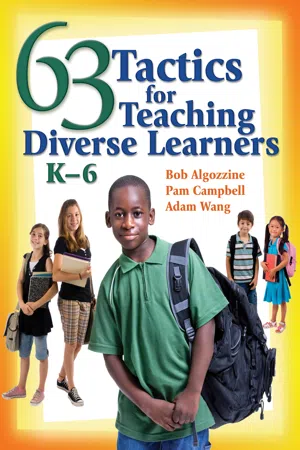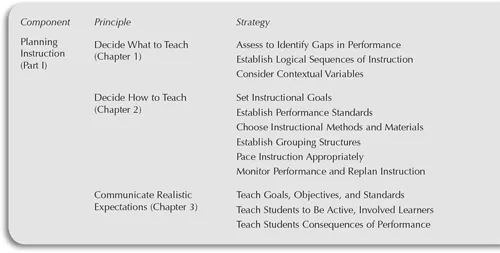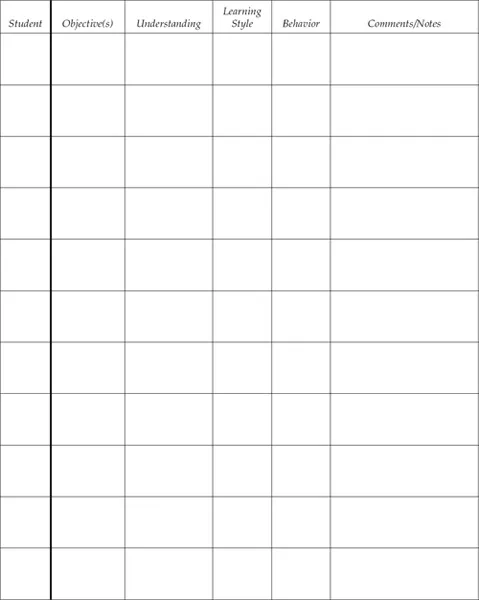
eBook - ePub
63 Tactics for Teaching Diverse Learners, K-6
This is a test
- 160 pages
- English
- ePUB (mobile friendly)
- Available on iOS & Android
eBook - ePub
63 Tactics for Teaching Diverse Learners, K-6
Book details
Book preview
Table of contents
Citations
About This Book
With a practical, research-based model, this resource offers proven instructional methods that can be used across content areas and grade levels for students with or without disabilities.
Frequently asked questions
At the moment all of our mobile-responsive ePub books are available to download via the app. Most of our PDFs are also available to download and we're working on making the final remaining ones downloadable now. Learn more here.
Both plans give you full access to the library and all of Perlego’s features. The only differences are the price and subscription period: With the annual plan you’ll save around 30% compared to 12 months on the monthly plan.
We are an online textbook subscription service, where you can get access to an entire online library for less than the price of a single book per month. With over 1 million books across 1000+ topics, we’ve got you covered! Learn more here.
Look out for the read-aloud symbol on your next book to see if you can listen to it. The read-aloud tool reads text aloud for you, highlighting the text as it is being read. You can pause it, speed it up and slow it down. Learn more here.
Yes, you can access 63 Tactics for Teaching Diverse Learners, K-6 by Bob Algozzine, Pamela Campbell, Jianjun Adam Wang in PDF and/or ePUB format, as well as other popular books in Education & Education Teaching Methods. We have over one million books available in our catalogue for you to explore.
Information
PART I
Planning Instruction
Effective teachers carefully plan their instruction. They decide what to teach and how to teach it. They also communicate their expectations for learning to their students. In this part of our resource, we describe evidenced-based strategies for each principle of planning instruction.

Planning Instruction Works: A Case Study
I’ve always considered myself an excellent planner, regardless of the fact that my principal reviews my plan book every Friday. I really want to be organized and prepared; you know, you have to be with 27 fifth graders in one room. So I’ve been very careful in deciding what and how to teach; I also know exactly what the instructional goals and objectives are each day. I have collaborated with our special education staff to ensure that each student’s Individualized Educational Plan (IEP) includes appropriate instructional goals and objectives that specify exactly how each objective will be taught and measured. The IEPs use the ABCC format: Actor (the student), Behavior (observable/measureable student action), Content (materials/methods used), and Criterion (how student performance will be measured). For example: “Given ten flashcards, John will be able to name ten CVC [consonant-vowel-consonant; e.g., h-a-t] words with 90 percent accuracy.”
So this year, it has been so helpful to have Mr. Laird, my special education coteacher, in my classroom for most of the day. Between the two of us, we are able to circulate around the classroom and really monitor and record student learning, as well as respond to any questions or problems students might be having. When we compare our notes, we are able to make accurate decisions about what and how to teach the next day. It’s really great because not only are we able to make immediate modifications for any of our students, we can be really smart about planning next steps and ensure that we’re adhering to IEPs. We are also really able to “close the loop” between evaluating and planning instruction. (Related tactic is located in Chapter 1: Decide What to Teach under Strategy: Assess to Identify Gaps in Performance.)
1
Decide What to Teach

Chapter 1: Decide What to Teach
| Strategy: | Assess to Identify Gaps in Performance |
| Focus: | Basic Skills; Content Skills |
| Area: | Reading; Mathematics/Problem Solving/Calculating; Writing; Social Studies; Science; Arts; Fitness |
| Learning Difference: | Attention; Cognition High; Cognition Low; Cognition Mixed; Health; Study Skills; Social Knowledge; Receptive Language/Decoding (listening, reading); Expressive |
| Language/Encoding (speaking, writing, spelling); Fine Motor (handwriting, articulation, etc.); Processing Verbal Information; Processing Visual Information | |
| Disability Category: | Specific Learning Disabilities; Attention Deficit/Hyperactivity Disorder; Visual Impairments; Deafness/Blindness; Gifted and Talented; Hearing Impairments; |
| Mental Retardation; Multiple Disabilities; Traumatic Brain Injury; Second Language Learning Needs; Serious Emotional Disturbance; Speech or Language Impairments; | |
| Orthopedic Impairments; Other Health Impairments; Autism | |
| Tactic Title: | Observing Students |
| Problem: | There are times when teachers of students with disabilities evaluate the students and design modifications for their instruction based on the students’ assessment test scores. |
| But what do these scores mean? Do these scores allow the teacher to meet the students’ needs appropriately? | |
| Tactic: | Direct observation can be used to gain a more comprehensive understanding of the students. While the students are working, walk around the classroom to monitor and record student progress. |
| Ask students questions regarding the lesson and the assignment. Use a checklist to assess desired objectives (see Student Observation Sheet). | |
| Write anecdotal records of students’ learning, including notes of inappropriate behaviors, underdeveloped thinking skills, on-task behaviors, the understanding of content instruction, or any other noticeable behavior that needs to be documented. | |
| Example: | Observing students as they are working provides a wonderful way for me to monitor their understanding. In fact, I use an Observational Journal to organize my notes during observation. |
| I monitor not only my students’ learning, but also their health. The number of days absent or their physical appearance can be a beneficial way of studying their work habits and social skills. | |
| (These areas are important to set the framework for the academic learning.) Gathering data through close observation also helps me when collaborating with parents and special education teachers. | |
| Parents and teachers can study my anecdotal records of students showing daily occurrences of behaviors and progress. In this way, decisions concerning the students’ education can be made appropriately. | |
| Rosemary T., teacher | |
| Benefits: | Measuring learning progress informally can
|
| Literature: | Burns, M. S., Delclos, V. R., & Kulewicz, S. J. (1987). Effects of dynamic assessment on teachers’ expectations of handicapped children. American Educational Research Journal, 24, 325–336. |
Student Observation Sheet

Copyright © 2009 by Corwin Press. All rights reserved. Reprinted from 63 Tactics for Teaching Diverse Learners, K–6 by Bob Algozzine, Pam Campbell, and Adam Wang. Thousand Oaks, CA: Corwin Press, www.corwinpress.com. Reproduction authorized only for the local school site or nonprofit organization that has purchased this book.
| Strategy: | Establish Logical Sequences of Instruction |
| Focus: | Basic Skills |
| Area: | Reading; Mathematics/Problem Solving/Calculating; Writing; Social Studies; Science; Arts; Fitness |
| Learning Difference: | Attention; Cognition High; Cognition Low; Cognition Mixed; Mobility; Hearing; Health; Memory Short-Term; |
| Memory Long-Term; Seeing; Speaking/Talking; Study Skills; Fine Motor (handwriting, a... |
Table of contents
- Cover Page
- Dedication
- Title
- Copyright
- Contents
- Preface
- Acknowledgments
- About the Authors
- PART I: PLANNING INSTRUCTION
- PART II. MANAGING INSTRUCTION
- PART III. DELIVERING INSTRUCTION
- PART IV. EVALUATING INSTRUCTION
- References
- Additional Readings
- Index